From: https://www.nga.gov/features/slideshows/patrons-and-artists-in-late-15th-century-florence.html#slide_1
Overview
In the late fifteenth century, Florence had more woodcarvers than butchers, suggesting that art, even more than meat, was a necessity of life. This was true not only for the wealthy, but also for those of more modest means. In 1472, the city boasted 54 workshops for marble and stone; it employed 44 master gold- and silversmiths, and at least thirty master painters. Florence’s position in the wool and silk industries relied on its reputation for quality—a tradition of craftsmanship that made discerning patrons of its merchants and financiers.
Most commissions were for religious works. Many banking families, for example, viewed the funding of altarpieces and chapels as a kind of penance for usury (moneylending at interest), which was condemned by the church but inherent to their profession. As the 1400s progressed, however, patrons became increasingly interested in personal fame and worldly prestige. Lavish, even ostentatious, public display became more common, even as the fortunes of the city declined. New subjects from mythology found eager audiences impressed by such evidence of learning. And, by the end of the century—for the first time since antiquity—some art was being made simply “for art’s sake.”
Among the greatest patrons in 15th-century Florence were members of the powerful Medici family, who ruled as princes, though the city was, in name, a republic. The works in this tour date from the time of Lorenzo de’ Medici, the Magnificent, whom Machiavelli called “the greatest patron of literature and art that any prince has ever been.” Although Lorenzo himself commissioned relatively few major works, he was an important arbiter of taste. An avid collector of Greek and Roman antiquities, he helped imprint the Florentine Renaissance with the humanism of the ancient world.
One of the artists employed by the Medici was Botticelli, a member of Lorenzo’s circle of poets and scholars. Botticelli’s lyrical paintings matched the cerebral refinement of Florence’s humanists, especially the Neoplatonic philosophers, who saw beauty as a way to approach an understanding of the divine. Botticelli’s ethereal figures, defined by line rather than modeled with light and shadow, seem to float, their drapery billowing in graceful patterns. His subjects, both mythological and religious, are imbued with lyricism and mystery.
Despite their delight in pagan themes, most Florentine humanists remained deeply pious. In the 1480s and 1490s, the Dominican friar Savonarola gave impassioned sermons attacking luxury and the amorality of ancient gods. He attracted many followers, including, it seems, Botticelli, who abandoned mythological subjects. After Lorenzo the Magnificent died in 1492, economic and political disasters put Florence in the hands of Savonarola’s radical religious reformers. Vigilantes patrolled the streets, and citizens consigned luxury goods, including untold numbers of paintings and other works of art, to the consuming flames of bonfires.
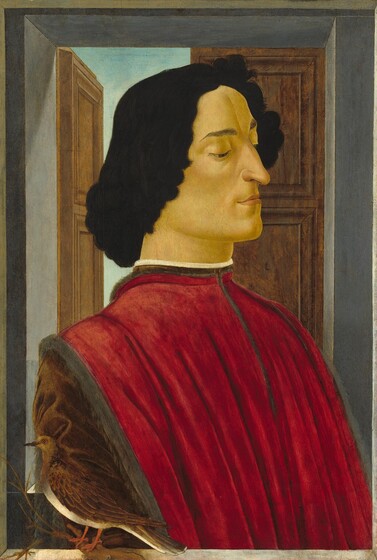
Giuliano Medici, the younger brother of Lorenzo, was nursing a bad knee on Easter Day 1478 and had to be helped to the cathedral—by the very men who were plotting to kill him and his brother during mass. The assassins, members and supporters of the Pazzi family, banking rivals of the Medici, awaited their signal. As worshipers bowed their heads at the elevation of the host, Giuliano was brutally stabbed. Lorenzo escaped to the sacristy, remaining there while the Pazzi partisans attempted to seize the government. They soon failed, however, and Lorenzo resumed control.
The murder of Giuliano shocked Florence, and a number of portraits were ordered for public display to serve both as memorials and as warnings to other plotters. Botticelli’s painting may have been the prototype for others, and lent symbolic gravity to Guiliano’s passing, showing him as an icon, almost a saint. The open window and mourning dove were familiar symbols of death, alluding to the flight of the soul and the deceased’s passage to the afterlife. Some scholars, noting the lowered eyelids, suggest this portrait was painted posthumously from a death mask.
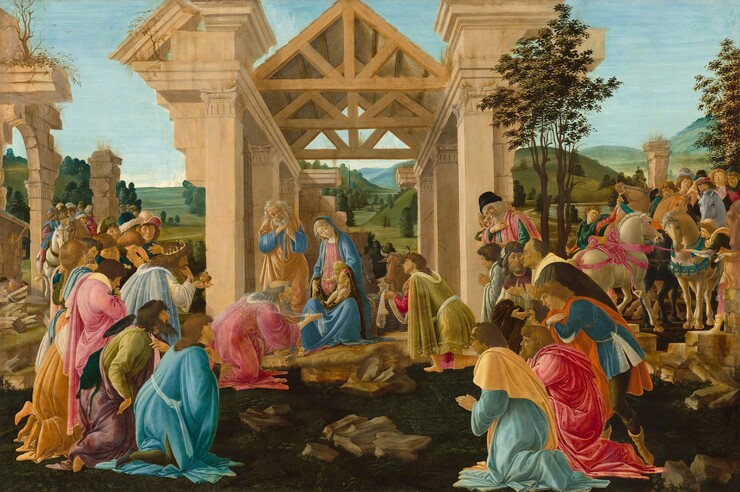
For most of the fifteenth century, the Epiphany was celebrated in Florence with a great festival. Expensively clad citizens reenacted the journey of the three kings to Bethlehem with processions through the streets. Shortly before this work was painted, however, the elaborate pageantry of the festival was curtailed. Preachers like Savonarola complained that excessive luxury obscured the day’s religious significance.
Botticelli’s painting seems to reflect this new concern. He places Jesus at the center of a powerful X formed by the opposing triangles of kneeling worshipers and the roof of the manger. The viewer, rather than being overwhelmed by rich detail, is instead aware of the quiet distance between him and the holy figures—and like the worshipers in the painting leans toward the infant. This yearning to close the gap between human existence and the divine was a frequent Neoplatonic theme.
Botticelli may have painted this while in Rome working on the Sistine Chapel. Rearing horses in the background, for example, appear to reflect the colossal horses of the Dioscuri. The classical architecture of the manger and the crumbling ruins also have theological significance. Legend held that earthquakes destroyed pagan temples at the moment Christ was born, and in a more general sense ruins suggest that the old order of the Law of Moses is supplanted by the new era of Grace made possible by Christ’s birth.
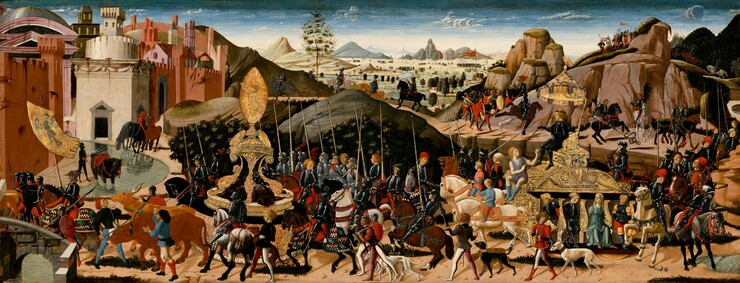
Subjects like this one, taken from the writings of the ancient Roman author Livy, displayed the learning and sophistication of Renaissance patrons and were especially popular in domestic settings. The size of this painting suggests that it was probably displayed like a frieze with other panels in the home of a wealthy Florentine family.
Here, the Roman senate honors the hero Camillus with a triumphal parade through Rome. Camillus returned from exile to rescue Rome from besieging Gauls. When informed that the city was ready to capitulate by paying off the enemy, Camillus stirred his troops and fellow citizens with powerful rhetoric. “With iron,” he said, “and not with gold, Rome buys her freedom.” This spirit of republican virtue appealed to fifteenth-century Florentines, who regarded ancient Rome as a paradigm for their own city. The scene’s relevance was enhanced by its contemporary costumes and other familiar details. The decorated parade floats recalled the lavish spectacle of processions in Florence. The battered and blood-stained walls of the city enclose several buildings that could be recognized in Rome, including the dome of the Pantheon and the drums of Castel Sant’Angelo. The heraldic colors that drape the horses probably belonged to the painting’s patron, as yet unidentified.
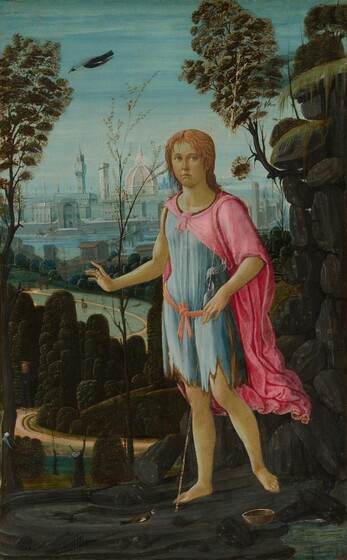
Small devotional images such as this were produced in large numbers by craftsmen and lesser-known artists for the homes of Florence’s middle class. These artists often filled in at leading workshops when extra assistants were needed for important commissions. We know, for example, that Jacopo worked with Filippo Lippi, Ghirlandaio, and Botticelli.
This painting reflects the concerns of Florentine merchants and their pride in the city. John the Baptist was the patron saint of Florence, and we see him here before the city skyline. Clear in the distant landscape are the Palazzo Vecchio, center of the city administration; Brunelleschi’s huge cathedral dome; and the campanile designed by Giotto. (It is one of our earliest painted views of Florence.) Other details preserve a traditional, conservative religious outlook. The bowl at the saint’s foot recalls his baptism of Christ, while goldfinches, whose red markings were believed to have been made by Christ’s crown of thorns, remind viewers of the Crucifixion. Most telling is the axe sunken into the tree trunk at the left edge of the painting, which refers to Luke 3:9: “every tree therefore which bringeth not forth good fruit is hewn down.” This was a pointed warning against the unorthodox beliefs of some of the city’s patrician elite, echoing Savonarola’s sermons against their dangerously paganlike tendencies.
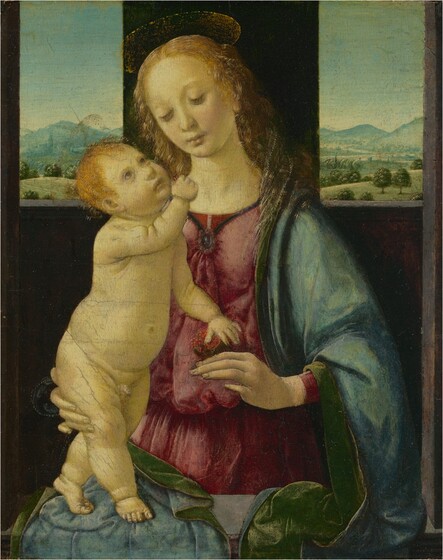
The workshop of a Renaissance artist was both studio and school, where apprentices were trained to paint in the style of the master. Since large commissions required the efforts of many painters, backgrounds, still-life details, and secondary figures were often painted by assistants. A master might also give lesser commissions entirely over to his assistants, simply approving the work as meeting his standard. It is often difficult to distinguish the work of the master from that of talented assistants whose individual styles were not yet fully developed.
This small devotional panel is painted in the style of Andrea del Verrocchio but is the work of one of his students, Lorenzo di Credi, who inherited the workshop when Andrea died. For inspiration Credi seems also to have looked to a fellow student—Leonardo da Vinci. This madonna is modeled after one by Leonardo; in fact, the painting was once thought to be an early work by Leonardo. But the colors differ from Leonardo’s subdued palette, and the landscape lacks his fanciful mountains. Notice, too, the Virgin’s left hand, which holds a pomegranate, symbol of the Resurrection. In Leonardo’s painting she holds a carnation. Credi failed to alter the position of her fingers, leaving her with an unnatural gesture unthinkable from such a keen observer of nature as Leonardo.
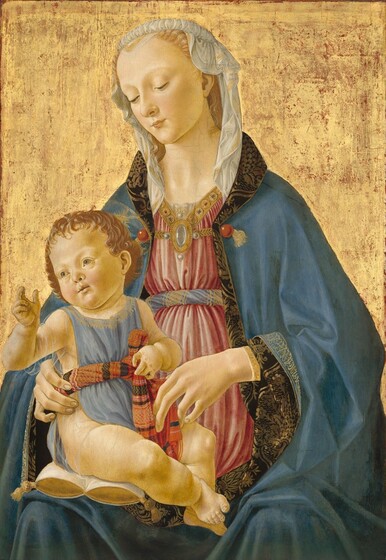
In a city filled with artists, the busiest workshop in the later 1400s was that of Domenico Ghirlandaio. His popularity rested on the conventional piety of his images, his direct and forthright style, and his high standards of craftsmanship. These qualities probably appealed to the average Florentine, who was less attracted by the humanist erudition and advanced tastes that enthralled the city’s elite. Works like this devout image contrast with the sensuality and luxury denounced by Savonarola.
The gold background is unusual—a little old-fashioned for a painting done in the 1470s. It is not clear whether the present gilt surface (not original) replaced original gilding or was applied over a now-obliterated landscape, such as seen elsewhere in this room. If the painting was gilded from the outset, this would have been specified in the contract between artist and patron. Until the mid-fifteenth century, the intrinsic value of materials—gold and costly pigments such as ultramarine, which is made from the semiprecious stone lapis lazuli—accounted for much of a painting’s worth. By the time this work was made, however, the emphasis had shifted. Patrons had come to value instead the skill of the painter, as we do today.
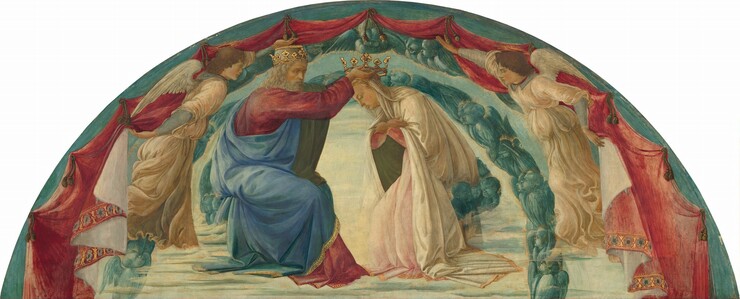
Filippino was the son of the artist Fra Filippo Lippi. His father, however, died when the boy was only twelve, about the age when he would have begun his artistic training. Filippino’s education was taken over by his father’s pupil, Botticelli, and their association lasted many years.
This painting is probably a very early work by Filippino—some, in fact, believe it to be his earliest one to survive. At this point in his career, Filippino was still strongly under Botticelli’s influence. The lyrical and graceful line—the rippling cascades of drapery and the fanlike fall of cloth at the Virgin’s hem—show Filippino’s debt to his teacher, but the confident colors are the artist’s own. As his style matured, Filippino moved away from the linearity of Botticelli. The diaphanous shimmer of fabric and sad delicacy of his faces give his works an elusive and poetic quality.
The half-round shape of this painting, called a lunette, was used most often over doorways. Probably this one was placed over the entrance to a private chapel or sacristy, but its original location remains unknown.
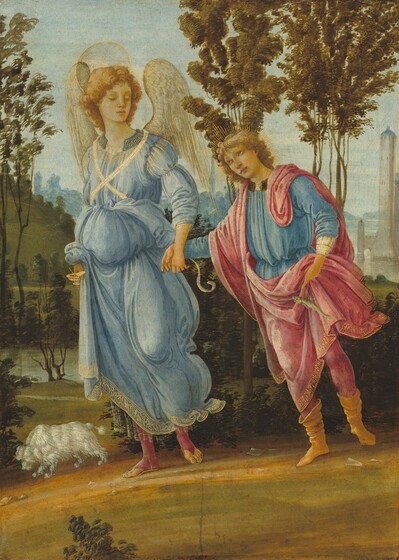
This painting is based on the Book of Tobit which tells the story of Tobit of Nenevah. Tobit is described as a man of good faith who suffers from blindness and poverty. He sent his son, Tobias, to a distant city to collect money he had deposited there, and hired a companion to accompany the youth. The companion was actually the archangel Raphael in disguise. Their journey was successful: not only was the money recovered, but medicine made from a monstrous fish Tobias encounters along the way cures Tobit’s blindness.
In Hebrew, Raphael’s name means “God has healed.” In this painting, Raphael holds a golden mortar used for compounding medicinal ingredients. Although the archangel is usually shown with a mortar or medicine box, his identity here is established by the presence of Tobias holding a fish. Raphael is named only in the Book of Tobit.
The story of Tobit may have been particularly popular in fifteenth-century Florence because of its appeal to merchant families, whose sons were often sent to trade in far-away cities. Paintings of Tobias and his angelic guardian were likely commissioned as dedications to ensure a safe journey, or offer thanks for a safe return. The painting’s suggestion of reward for fair dealing may have been equally welcome.
